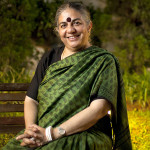COP21: Emissions Gap Must Be Addressed
TRANSCEND MEMBERS, 28 Dec 2015
Prof. Vandana Shiva – Asian Age
17 Dec 2015 – In 1992, when the United Nations Framework Convention on Climate Change (UNFCCC) was agreed upon, the threats to survival were seen to be a century away. Now they pose a clear and present danger. The destruction of Syria is a sad example of an ecosystem and civilisational collapse. We are in a planetary emergency.
This is a result of Conference of Parties to the UNFCCC (COP15) at Copenhagen in 2009, where US President Barack Obama, along with the big polluters, undermined legally binding global targets and prompted a shift to voluntary commitments by countries. India was part of this shift to national voluntary commitments. As noted above, we are on the verge of an ecosystem and societal collapse and we need to address this reality. For this each citizen and his/her country must act.
On December 12, 2015, governments of the world agreed to a historic agreement on climate change in Paris at COP21. Paris was a wakeup call for governments to take actions to stop the buildup of greenhouse gases (GHGs) that are causing climate instability and aggravating disasters like the recent Chennai floods, the 2013 Uttarakhand disaster, the untimely rains of April 2015 which destroyed the rabi harvest in North India, the extreme drought that Bundelkhand, Maharashtra and Rajasthan are currently experiencing with severe consequences for farmer livelihoods and food security.
While the Paris agreement is not enough to avert such disasters, it has put up a warning sign that we must hold the increase in the global average temperature to well below 2° Celsius above pre-industrial levels. It also lays emphasis on pursuing efforts to limit the temperature increase to 1.5° Celsius, recognising that this would significantly reduce the impact of climate change.
However, there is a significant gap between the aggregate effect of national mitigation pledges made voluntarily by governments and the global reduction of GHGs necessary to achieve the 1.5° Celsius target.
This “emissions gap” cannot be enforced through the Paris agreement. It rests on nations scaling up their commitments to reduce emissions, but most importantly, on citizens’ movements leading the path to a lower GHG pathway, while enhancing climate resilience and human well being. That’s why citizens must push for “liability” in terms of emissions — the principle “polluter pays”. Only when the destruction of plant and human lives is perceived as a crime against nature and humanity will this emissions gap be closed.
In 2007, in the run up to COP15, my research showed that 40-50 per cent of all GHGs including CO2, nitrogen oxide from chemical fertilisers and methane from food waste in landfills and factory farming came from a fossil fuel-based industrial model of agriculture.
The work of various non-governmental organisations, movements for ecological agriculture and of UN agencies shows that a transition from a fossil fuel-based agriculture to ecological agriculture dramatically reduces GHGs. Only by returning organic matter to the soil can we absorb the excess CO2 from the air and put it in the soil where it belongs.
Soil rich in humus and organic matter produces more and healthier food which is poison-free. It also retains more water. Thus, organic agriculture addresses food security of health, water and climate, all on its own. Transition to organic agriculture also reduces dependence on costly chemical inputs.
Imagine if the 2015 Paris Climate Conference, COP21, had collapsed like Copenhagen? It would have been a free run for polluters in the absence of emissions cuts targets.
______________________________
TRANSCEND Member Prof. Vandana Shiva is a physicist, ecofeminist, philosopher, activist, and author of more than 20 books and 500 papers. She is the founder of the Research Foundation for Science, Technology and Ecology, and has campaigned for biodiversity, conservation and farmers’ rights, winning the Right Livelihood Award [Alternative Nobel Prize] in 1993. She is executive director of the Navdanya Trust.
DISCLAIMER: The statements, views and opinions expressed in pieces republished here are solely those of the authors and do not necessarily represent those of TMS. In accordance with title 17 U.S.C. section 107, this material is distributed without profit to those who have expressed a prior interest in receiving the included information for research and educational purposes. TMS has no affiliation whatsoever with the originator of this article nor is TMS endorsed or sponsored by the originator. “GO TO ORIGINAL” links are provided as a convenience to our readers and allow for verification of authenticity. However, as originating pages are often updated by their originating host sites, the versions posted may not match the versions our readers view when clicking the “GO TO ORIGINAL” links. This site contains copyrighted material the use of which has not always been specifically authorized by the copyright owner. We are making such material available in our efforts to advance understanding of environmental, political, human rights, economic, democracy, scientific, and social justice issues, etc. We believe this constitutes a ‘fair use’ of any such copyrighted material as provided for in section 107 of the US Copyright Law. In accordance with Title 17 U.S.C. Section 107, the material on this site is distributed without profit to those who have expressed a prior interest in receiving the included information for research and educational purposes. For more information go to: http://www.law.cornell.edu/uscode/17/107.shtml. If you wish to use copyrighted material from this site for purposes of your own that go beyond ‘fair use’, you must obtain permission from the copyright owner.
